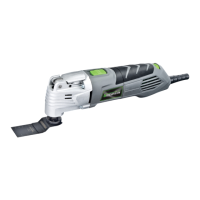5
English
EXTENSION CORDS
Grounded tools require a three wire extension cord. Double insulated tools can use
either a two or three wire extension cord. As the distance from the power supply outlet increases, you must use a
heavier gauge extension cord. Using extension cords with inadequately sized wire causes a serious drop in voltage,
resulting in loss of power and possible tool damage. Refer to the table shown below to determine the required
minimum wire size.
The smaller the gauge number of the wire, the greater the capacity of the cord. For example: a 14-gauge cord
can carry a higher current than a 16-gauge cord. When using more than one extension cord to make up the total
length, be sure each cord contains at least the minimum wire size required. If you are using one extension cord for
more than one tool, add the nameplate amperes and use the sum to determine the required minimum wire size.
Guidelines for Using Extension Cords
• If you are using an extension cord outdoors, be sure it is marked with the suffix “W-A” (“W” in Canada) to
indicate that it is acceptable for outdoor use.
• Be sure your extension cord is properly wired and in good electrical condition. Always replace a damaged
extension cord or have it repaired by a qualified person before using it.
• Protect your extension cords from sharp objects, excessive heat, and damp or wet areas.
SPECIFIC SAFETY RULES FOR MULTI-PURPOSE
OSCILLATING TOOLS
WARNING: DO NOT LET COMFORT OR FAMILIARITY WITH PRODUCT (GAINED
FROM REPEATED USE) REPLACE STRICT ADHERENCE TO PRODUCT SAFETY RULES. If
you use this tool unsafe or incorrectly, you can suffer serious personal injury!
WARNING: Hold tool by insulated gripping surfaces when performing an
operation where cutting tools may contact hidden wiring or its own cord. Contact with a
“live” wire will make exposed metal parts of the tool “live” and shock the operator!
•
Always wear safety glasses or goggles. Normal prescription eye or sunglasses are not
safety glasses.
•
Hold the Oscillating Tool by its insulated gripping surfaces to avoid electrical shock
from unseen “live” wires.
•
Always hold the tool firmly. Do not leave the tool running unless hand held.
•
Check your work area for proper clearances before cutting. This will avoid cutting
into your workbench, the floor, etc.
•
Do not cut nails or screws unless you are using a blade specifically designed for this purpose.
Inspect your material before cutting.
•
Before switching on the tool, be sure the blade is not contacting the work piece.
•
Do not use tool if switch does not turn it on or off. Any tool which can not be controlled
by the switch is dangerous and must be repaired.
•
Wear cushioned protective gloves to minimize the vibration. Excessive vibration
may cause personal injury.
Recommended Minimum Wire Gauge for Extension Cords (120 Volt)
Nameplate
Amperes
(At Full Load)
Extension Cord Length
25 Feet 50 Feet 75 Feet 100 Feet 150 Feet 200 Feet
0–2.0 18 18 18 18 16 16
2.1–3.4 18 18 18 16 14 14
3.5–5.0 18 18 16 14 12 12
5.1–7.0 18 16 14 12 12 10
7.1–12.0 18 14 12 10 8 8
12.1–16.0 14 12 10 10 8 6
16.1–20.0 12 10 8 8 6 6

